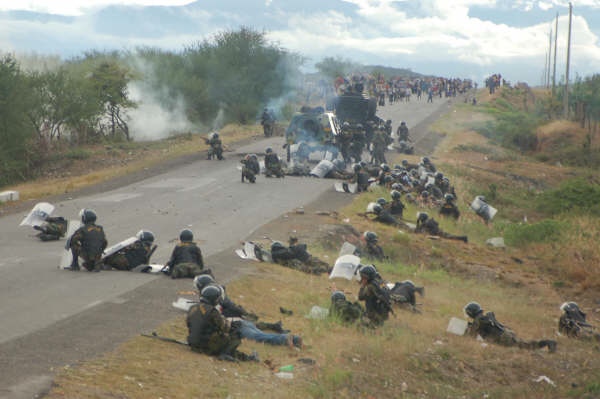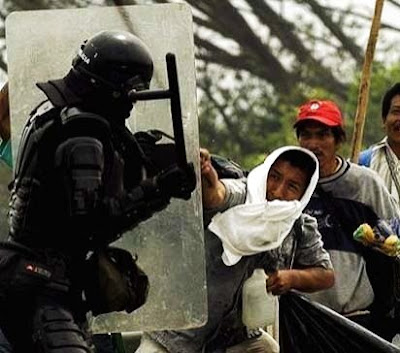INFORME OFICIAL DE LOS SANGRIENTOS HECHOS DE BAGUA (alternativo)
.
Listen please president Alan Garcia, you are responsible because you have exterminated us, you are killing us, you are selling us. You are the terrorist.
.
.
Subido por ArchivoDeNoticias el 10/06/2009
MADRE INDÍGENA HABLA AL PRESIDENTE ALAN GARCIA PEREZ MASACRE EN BAGUA TRADUCCION SUBTITULADA
A native mother who is in pain for the lost of her people talks in her language and she has the right to be listened and understood around the world: " Listen please president Alan Garcia, you are responsible because you have exterminated us, you are killing us, you are selling us. You are the terrorist. We defend our territory from armament Our only weapon of defense is just arrows and sticks, that arent long range and they aren´t meant to kill like you did with us. You exterminated us using armament, bullets, helicopters and killed our brothers, sisters, students, teachers, sons... Alan we ask you to come over here to our territory to pay the debts you have to us. Alan, you sell our country, you sell our people, you sell our natural resources, gold, oil, water, air You pollute our environment and so you will leave us even poorer as you can see us now.. this is how we are and how we are left. We, the awajón-wampis people haven´t elected
you to exterminate us, but to help us, to provide us with education for the kids you killed now. We aren´t taking your private property, we haven´t killed your kids or family, you already exterminated us and now we have NOTHING!".
.
.
BAGUA MASSACRE
http://en.wikipedia.org/wiki/2009_Peruvian_political_crisis
The 2009 Peruvian political crisis resulted from the ongoing opposition to oil development in the Peruvian Amazon, with local Native Americans opposing Petroperú and the National Police. At the forefront of the movement to resist the development was AIDESEP, the coalition of indigenous community organizations.[1]
The crisis involved over one year of declared opposition and advocacy, and 65 straight days of civil disobedience. In June 2009, the Garcia government suspended civil liberties, declared a state of emergency, and sent in the military to stop the protests.[2] The military intervention resulted in two days of bloody confrontations,[1] in which, according to first reports, at least 22 soldiers (7 by spears), and least 30 indigenous people (including 3 children) were killed.[3]
This conflict has been described as Peru's worst political violence in years and is the worst crisis of President Alan García's presidency.[4][5]Prime Minister Yehude Simon was forced to resign his post in the aftermath, and Congress repealed the laws that led to the protests.
BACKGROUND
A free trade agreement negotiated between Peru and the United States that came into effect in February 2009 required certain changes in law allowing access to the Amazon. The Congress of Peru granted the government authority to implement the required regulatory changes. Indigenous tribes insist that some of the new government regulations brought in by President Alan García in 2008 threaten the safety of their natural resources and would enable foreign companies to exploit them. Protests ensued in August 2008 and Congress repealed two laws and promised to examine and vote on others. When that didn't happen, protests and blockades resumed in April 2009.[6][7][8]
Mineral exploitation is nowadays attacked by researchers having shown a link between the abundance of natural resources (particularly minerals and oil) of a country and its poor growth performance, as well as poor governmental policies and institutions (corruption, weak governance, rent-seeking, plunder). This seems especially true for 'point source' minerals such as mine and oil fields, which produce high value for few people, as opposed to agricultural diffuse development which involves large quantities of workers forcing a share of benefits.[9] Some believe that Peruvian oil development functions in such a model of 'point source', providing grievances and low benefit to local populations.
In 2008 an oil scandal shook the government of Alan Garcia when audio tapes were released to the press.[10] The tapes contained the conversations of Rómulo León, an important member of the ruling Apra party negotiating bribes from foreign companies in order to allow them to drill for petroleum in the Peruvian amazon region. Romulo León was imprisoned, yet his daughter, Luciana León, a member of congress, continues to work in the parliament despites e-mail messages found by investigators that revealed that she was aware and participating in her father's activities.[11]
In June 2009, as the dispute worsened, the military was called in to assist the police.[8] The deaths occurred as a result of two clashes fought in the Amazon jungle on 5 and 6 June 2009.[5]
Battle at "Devil's Curve"
On 5 June 2009, at least 31 people were killed in clashes between security forces and indigenous people on the "Devil's Curve" jungle highway close to Bagua, over 1,000 kilometres north of Lima, as the security forces attempted to break down a road blockade.[5][8] The deaths came when police decided to break down a blockade of 5,000 protesters.[4] 9 of the dead were tribesmen and 23 were members of the police force.[8] The tribes accused the police of firing with helicopters on those protesting peacefully below, with Alberto Pizango, an indigenous leader, telling journalists that the government was responsible for the massacre.[8][12] Police said they had been fired upon initially and the President said the tribes had "fall[en] to a criminal level".[8]
.
6 June 2009 massacre
On 6 June 2009, a further 9 police officers were killed at a petroleum facility belonging to a national oil company, Petroperú, which had been seized by the protesting indigenous tribes.[4][13] Prime Minister Simon said the officers were killed as they tried to rescue 38 kidnapped police officers.[13] García criticised the protesters, claiming they had behaved like terrorists and vaguely suggested that they may have been "incited by foreigners".[5] Several police had been taken hostage, although 22 were freed and 7 were missing.[5][13] This was later revised to one missing policeman.[14]
A 3:00 p.m. – 6:00 a.m. curfew was announced immediately.[4]
According to Amazon Watch, the police staged a violent raid on the unarmed indigenous people who were participating in a peaceful blockade to revoke the "free trade" decrees, issued by President Garcia in the context of the Free Trade Agreement with the United States. During that day, over 600 police attacked several thousand unarmed Awajun and Wambis indigenous peoples (including many women and children) and forcibly dispersed them using tear gas and live ammunition. The 9 police officers were killed when, after the police started shooting at the protestors, some indigenous were able to take away some of their guns and fight back. In the end, 25 civilians died and more than 150 were wounded.[15]
The police were accused of burning bodies to hide the death toll.[3]
At least 155 were injured, one third by bullet wounds.[4] 72 people were arrested.[4] The toll was expected to rise.[13] Not since the conflict with the Shining Path were so many people been killed or injured in political clashes of this nature in Peru.[4]http://en.wikipedia.org/wiki/2009_Peruvian_political_crisis
Consequences
AIDESEP leaders prosecuted, asylum for Pizango
On June 9, the government of Peruvian President Alan García still refused to meet with the indigenous coalition AIDESEP.[1]
The Peruvian government sought to arrest Alberto Pizango, a Shawi Indian leader of the indigenous protesters and head of their organization AIDESEP,[7] for sedition. Pizango entered Nicaragua's embassy in Lima on June 8 and was granted asylum the next day.[16] Four other AIDESEP leaders were accused of disturbing the peace and advocating sedition and revolt and faced up to six years in prison.[17]
Decrees suspended, then overturned
In the week following the clashes, Congress suspended two of the offending government decrees. The indigenous protesters vowed to continue until the decrees were repealed and not just suspended.[18] On June 18, Congress overturned two of the decrees, causing the protesters to halt their blockades.[19]
Vildoso and Simon resign
Carmen Vildoso, minister for Women's Issues and Social Development, resigned on June 8 to protest the government's actions.[7]
Prime Minister Yehude Simon negotiated the deal to overturn two decrees mentioned above and announced on June 16 that he would resign "in the coming weeks" over the government's handling of the crisis. President Alan García had appointed Simon, who is politically to the left of García, in October 2008 in an effort to mollify the country's poor and hard-line leftist nationalists.[20]
Peruvian government accused of undermining press freedom
In June 2009, Human Rights Watch condemned the Peruvian government's decision to revoke the broadcast license of a local radio station stating that "The timing and circumstances of the revocation suggest that it may have been an act of censorship, or punishment, in response to coverage of anti-government protests on June 5, 2009."
"If there is in fact credible evidence that a radio station has actively supported or incited violence, then the broadcasters should be subject to investigation and sanction, with all appropriate judicial guarantees," said José Miguel Vivanco, Americas director at Human Rights Watch. "But closing down a station this way certainly looks like retaliation for coverage the government didn't like."[21]
See also
Sarayaku – a forest Ecuadorian village having successfully slowed oil explorations
Oil exploration
Amerindians
http://en.wikipedia.org/wiki/2009_Peruvian_political_crisis -
-



